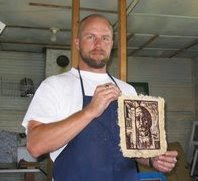When building an artists' community the first thing artists need is space to create. Most call this a "studio" though I don't think an artist needs to go that far in order to get work off the easel. This "space" must have access to the requirements of the media (the materials an artist uses to make his or her art) as a minimum, and a means of reasonable security: An artist must be able to lock up and walk away without fear of damage to the work or loss. This space need not be an elaborate thing as one might think having watched enough television to assume the workspace must meet some visual definition of a "studio" or "must inspire" the artist. Artists can take their inspiration from a number of sources; scenic views, the city, people, stories, almost anything! (Besides, I'd be a little suspicious of the merit of an artist's work that found its only inspiration from the working environment.) Ask anyone who is sick of their cubicle at work- work still gets done, though I will admit, it is probably not as enjoyable as completing the work in an office with a view. Studio needed? No, just work space. If we do not call this space a "studio" other opportunities open.
The reason for pointing out exactly what kind of space an artist needs is that many communities overreach when they consider providing space for artists placing unnecessary burden on both the community and the artist. Communities often approach this by offering a large building constructed or redesigned specifically with artists in mind. Small, blank workspaces grouped together with other small blank workspaces with an office space mentality. As I've mentioned, artists need work space not a studio, there's a difference! Another common mistake is to think about artist spaces as apartments- make them small, sterile, and ... oh ya, charge rent. Then they can say, "see, we are providing space for artists," and pass financial burden on to the shoulders of the artist and increase the artist's risk or need for commercial success. Not to mention the risk shared by the community if the space go unused without the rent to pay back the taxpayers. Because artists need low risk workspace much less is required and desired by the artist.
Look, as I've already written, a small space (about 13' X 20' floor space) - enough for a couple of easels, a flat file, and a cabinet for supplies is enough space for an artist to get started. How many streets are lined with nice restaurants below an empty second level with 85% of the shades drawn over the windows with the rest revealing "bookshelves" (this is the name that is given to refuse containers used for self deception) full of things no longer needed? How much room is "used" way in the back of the shop for items of little or no value? This space is wasted space, this wasted space is artist's space that could be made available through the help of the community to the artist.
I propose civic organizers simply coordinate unused space in businesses already active and successful in the community! Coordinate the space as a donation from the business, offer some tax breaks or advertising perks, and an artist has workspace risk free- or at least the risk is shared by the community. I mean really, imagine how many store fronts have "storage space" filled with boxes and unused office furniture that would much rather get a tax break (not to mention a free rotating art collection) for letting an artist use the "storage space" as work space? Any community incentive for the business would surely help reduce the risk inherent in establishing an artist at a very small price. The price might simply amount to collecting an inventory of available space and presenting it as available to artists: "Artists wanted- free studio space, visit the chamber of commerce website," - space made available, coordinated through the city, artist community started! No new construction, no financial risk, no contributions needed, just a community working together as a community for the sake of a community (and, of course, art).
The artist's community is started but not finished. More on that in future posts...


 I enjoy the organization and system of the old library card catalogs and similar outdated systems. Printed text has changed considerably with the advent of digital media and with that refinement a certain amount of apparent human connection with the writing. I am working with the idea of a system that, in a sense, removes that personal impact from the resulting creation while, because of the inherent flaws and unique characteristics of the typewriter, a trace of human contact is remains.
I enjoy the organization and system of the old library card catalogs and similar outdated systems. Printed text has changed considerably with the advent of digital media and with that refinement a certain amount of apparent human connection with the writing. I am working with the idea of a system that, in a sense, removes that personal impact from the resulting creation while, because of the inherent flaws and unique characteristics of the typewriter, a trace of human contact is remains.









